
Photo:
Refreshed Caring Cove play area at the Seattle Aquarium. Credit: Natasha Dillinger
Some of my fondest memories of my kids’ infancies revolve around taking them to the Seattle Aquarium. Their little eyes would fill with wonder at the marine animals swimming right in front of us in sky-high tanks. We always loved the Underwater Dome and Window on Washington Waters exhibits.
Sadly, between the pandemic and the lengthy construction on Alaskan Way (more on this later), we fell out of our visiting routine. Motivated by the unveiling of the new Caring Cove play area, we planned a trip to revisit all of our aquatic friends.
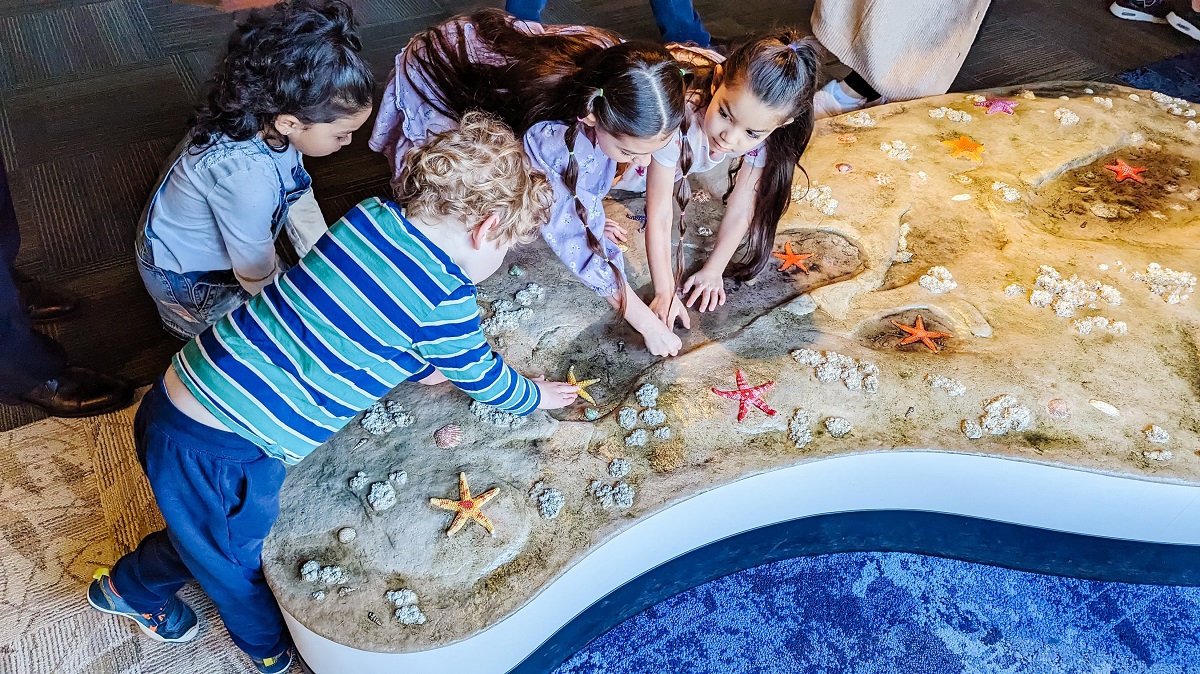
Swim right up to Caring Cove
The Caring Cove play area sits just past the touch pools and across from restrooms. The legacy space never seemed to attract more than a passing glance from my kids, so I was delighted to see it looking brighter and more welcoming than we’d found it in the past.
The touch pools’ gravitational pull almost sucked my preschooler in (what is it about kids and water?), but it wasn’t hard to temporarily pull him away once he, too, saw the refreshed play space.
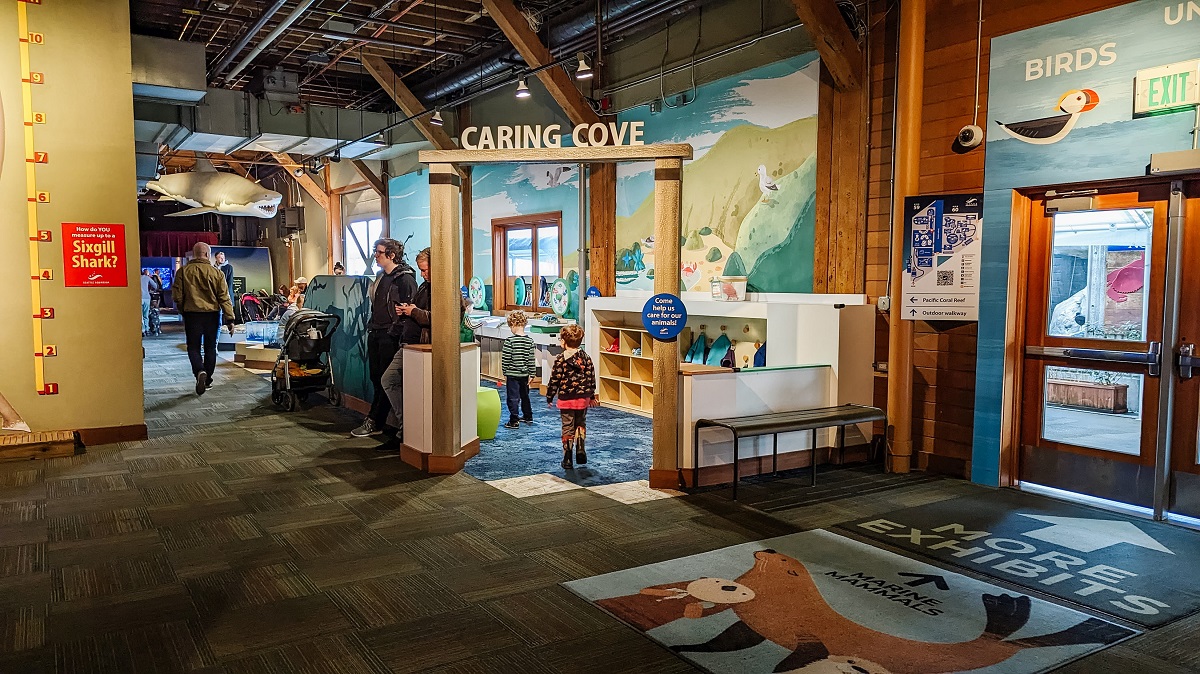
Brightly colored murals depicting sea life lure kids through an inviting arch. A half-height divider separates children at play from passing foot traffic and creates a natural tunnel that draws them through multiple interactive zones.
Hands-on play
Start by donning a vest like a real Aquarium staff member, or just dive right in like my son and his friend did. A selection of plush animals rests in cubbies just waiting for their veterinary checkups. Tools such as X-ray light tables, stethoscopes and syringes await, ready to assist mini marine caretakers in helping the animals.
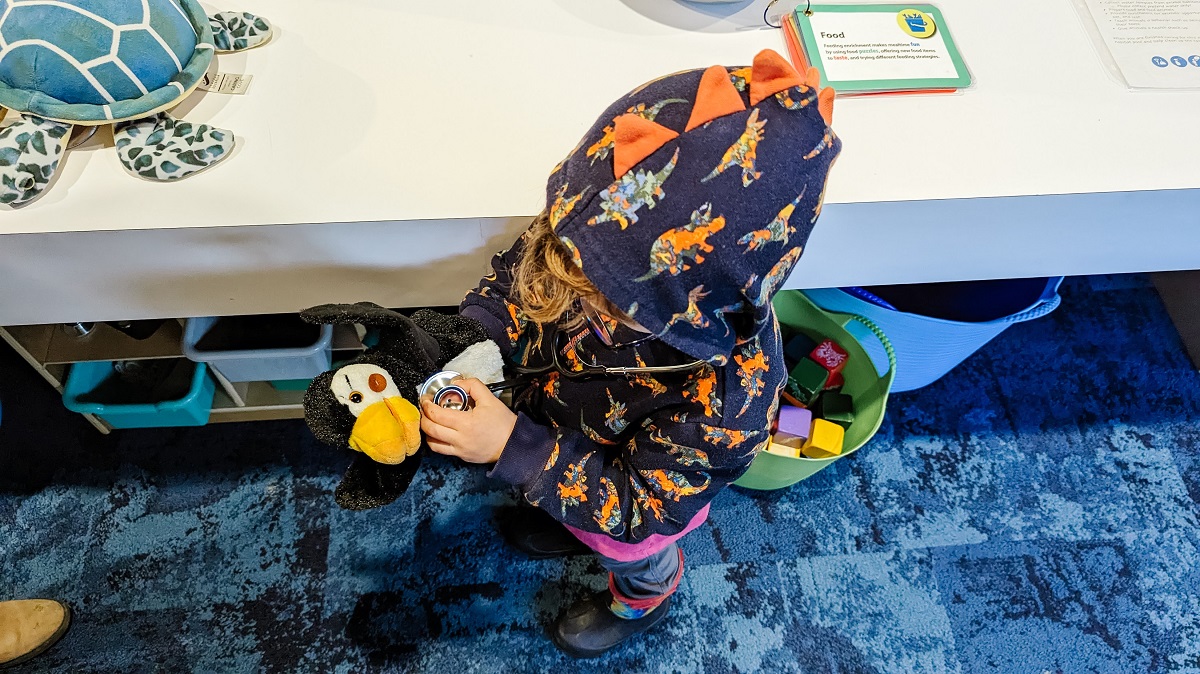
I loved that there are subtle opportunities for learning — my 4-year-old recently started to read numbers and could see for himself that a fish might weigh seven pounds (a turtle’s hefty 350-pound weight was beyond comprehension for now).
Kids can practice preparing a meal by matching colored blocks to a chart with marine animals’ favorite foods — red for crabs, blue for fish and … green for squid?
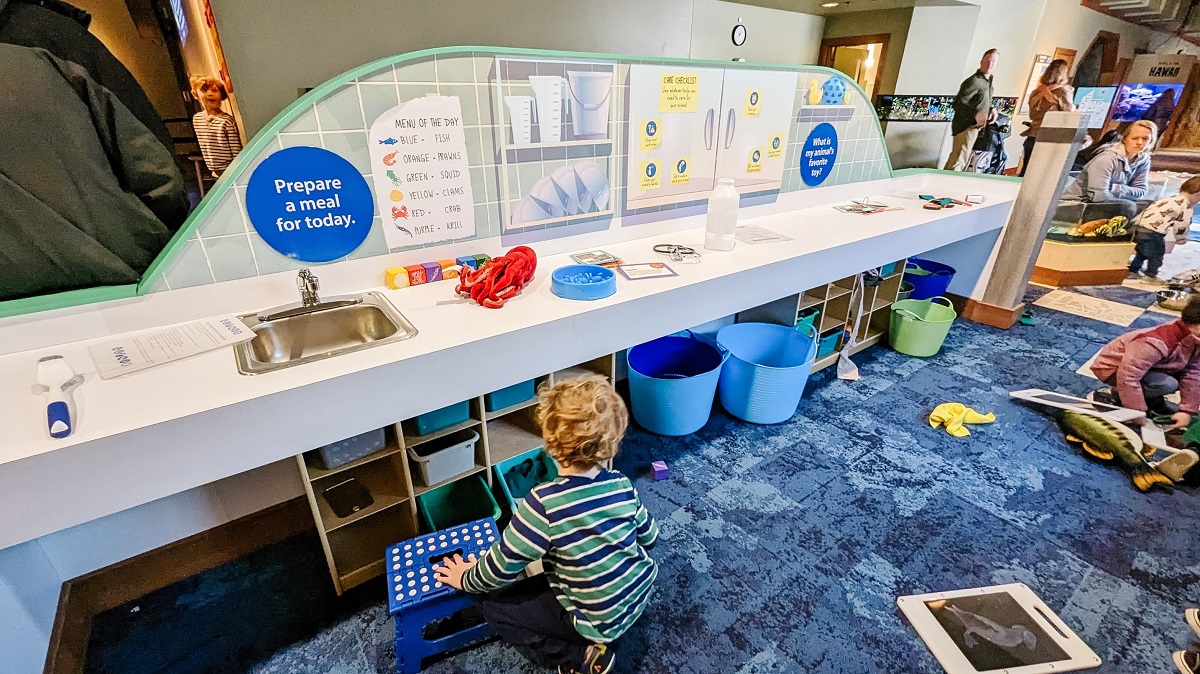
Popular spot
It’s not surprising that the space is popular. When it got busy, the galley-kitchen-style layout felt a bit crowded, and I appreciated being able to move down towards the more spacious faux tide pools.
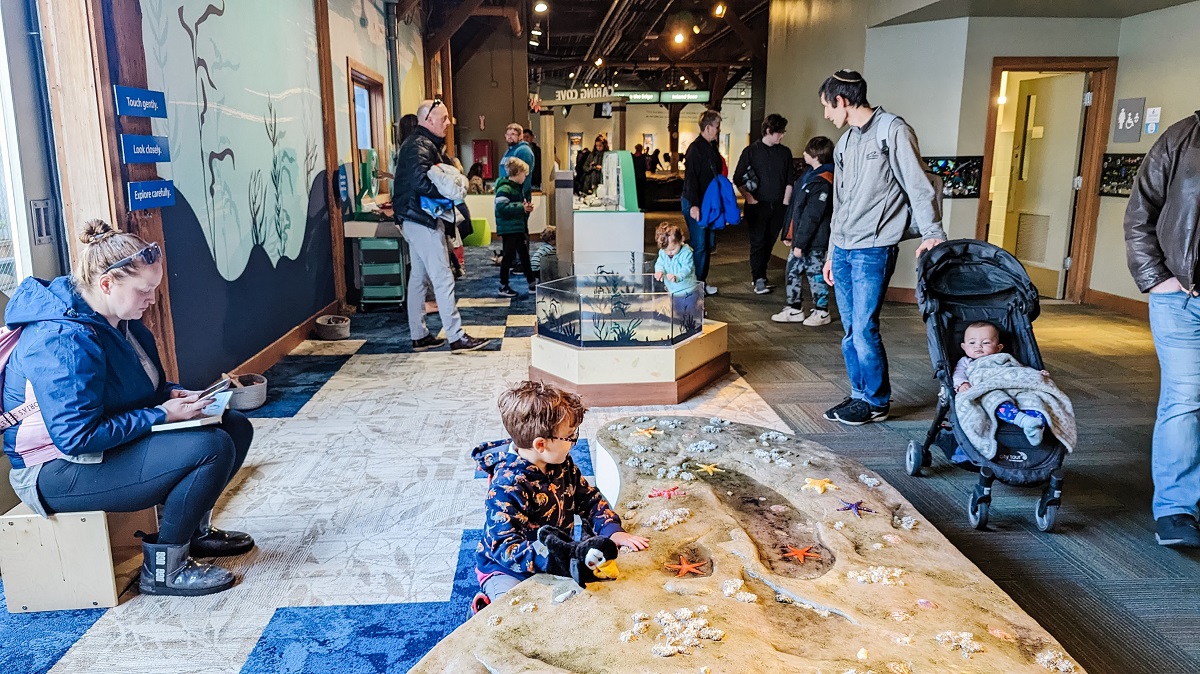
Designed to replicate the water-filled version just a few yards away, these cute tanks are located low to the ground so even the tiniest cruiser can reach in to gently stroke a plush sea star.
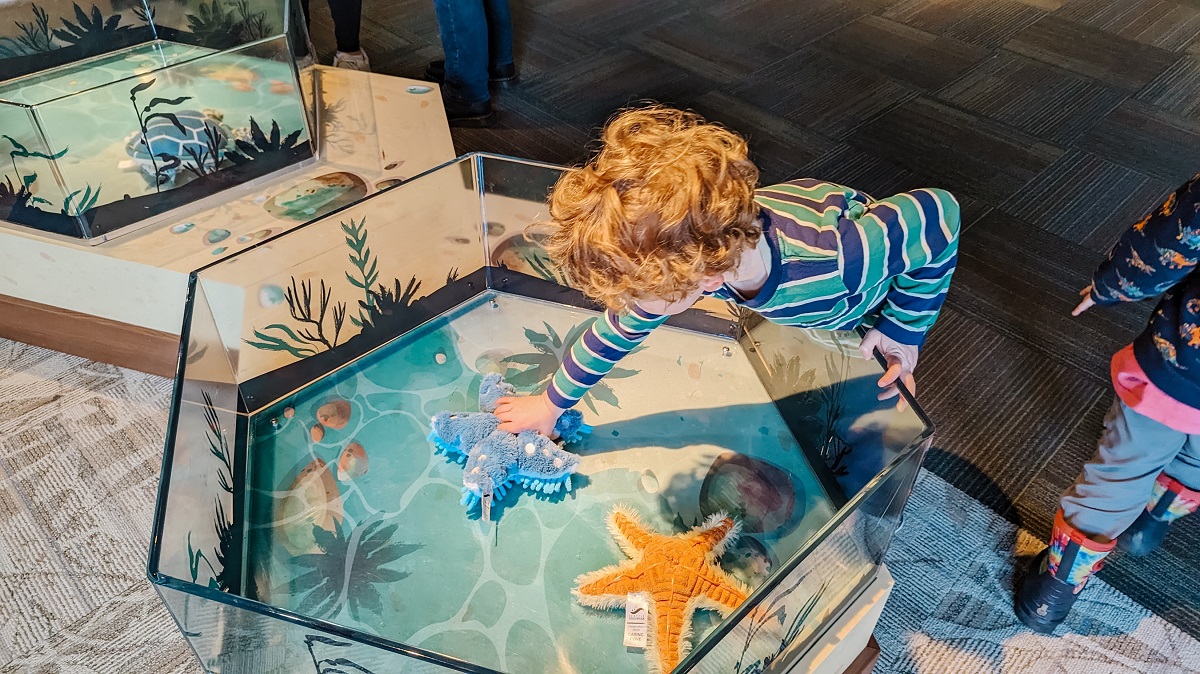
Nearby, a felt wall invites kids to create their own marine scenes. I confess that I enjoyed this perhaps even more than my son did. As a dedicated fan of the Aquarium’s popular summer Beach Naturalist program, I loved that the felt animals included species that you might spot in a real Puget Sound tide pool — golden sea lemons (a type of nudibranch, or sea slug), brown chitons (a prehistoric-looking mollusk) and salmon-colored sea pens were all up for decorating duty.
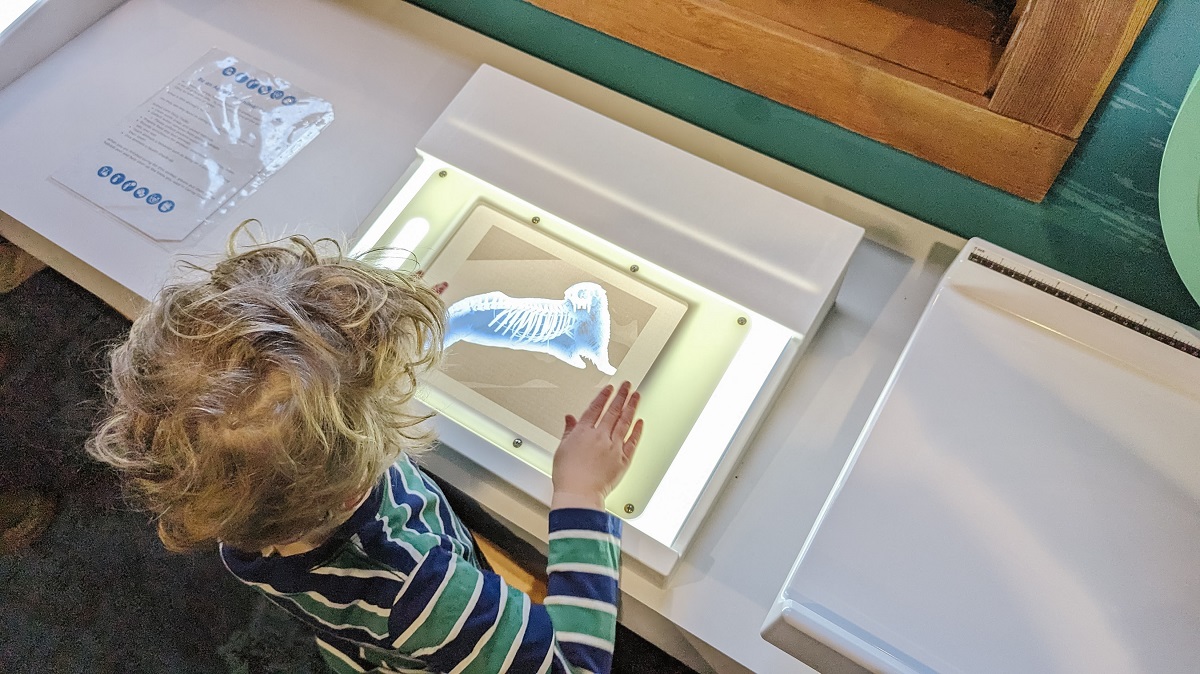
Seeds of stewardship
The idea for Caring Cove developed through the Aquarium’s empathy work, designed to help children see that marine animals need food, a safe home and nurturing care just as we humans do.
As I contemplated a young girl gently bandaging a sea star’s arm and my son feeding “milk” to an octopus (guess he didn’t read the feeding chart), it felt like the little seeds of sea stewardship were already starting to sprout.
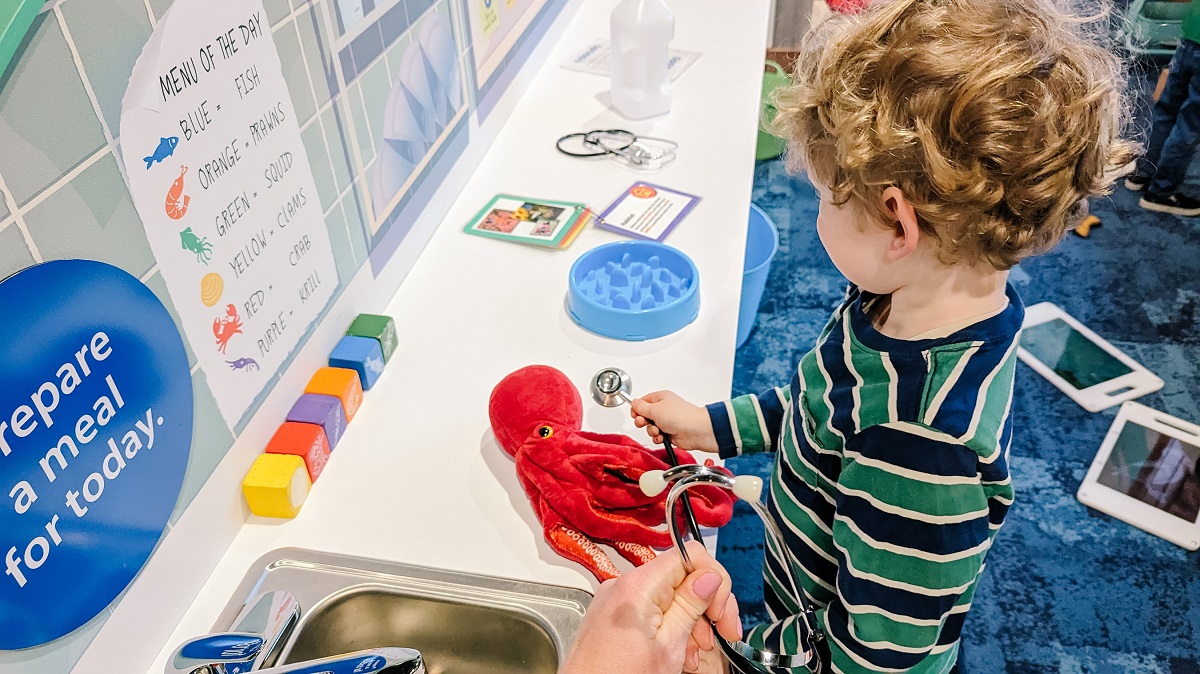
More fun at the aquarium
It’s worth noting that we revisited Caring Cove three times over the course of our trip. Like the tides, crowds tend to ebb and flow, so when it got too busy for us, we took a break to explore other activities.
Our friends hadn’t been to the aquarium before, so we got to play tour guide and watch the magic of discovery in new eyes. Pickles, the octopus that joined the aquarium earlier this year, kindly flashed us with all eight sucker-covered arms against the glass.
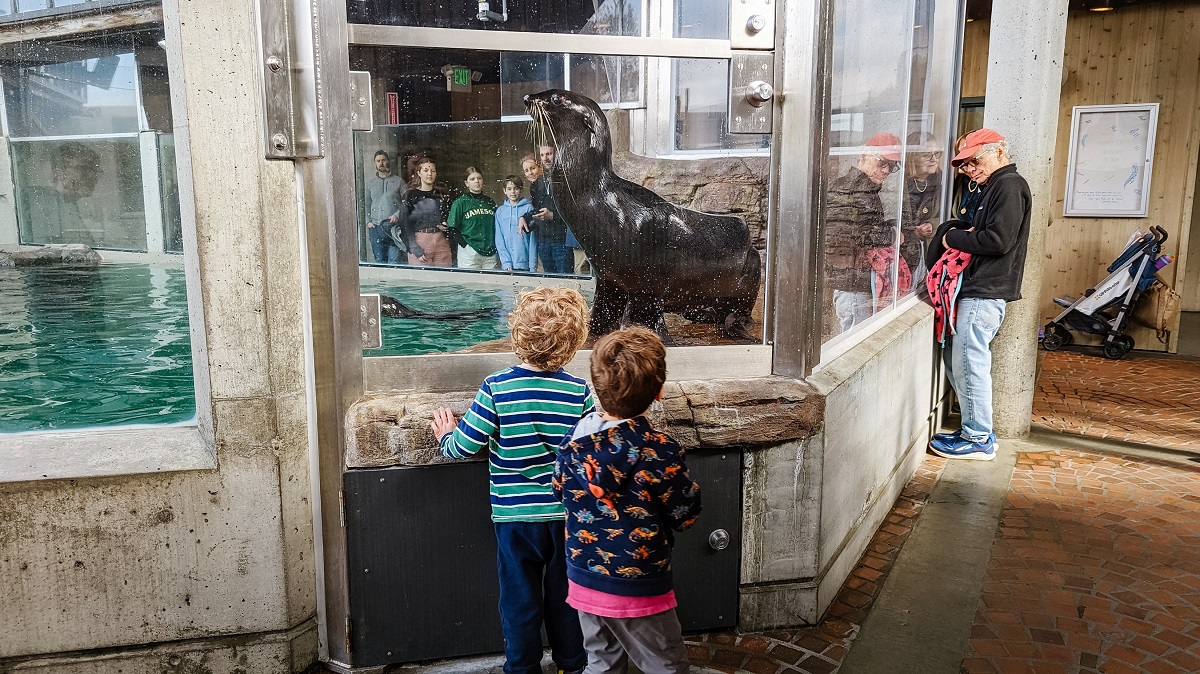
We caught the tail-end (mom joke, I know) of harbor seal and northern fur seal feedings, and even watched as one of the fur seals hopped up against the glass to show off his sleek black fur.
My son even made it back to the touch pools to inspect the anemones — it’s not an aquarium visit for our family unless at least one child soaks a sleeve.
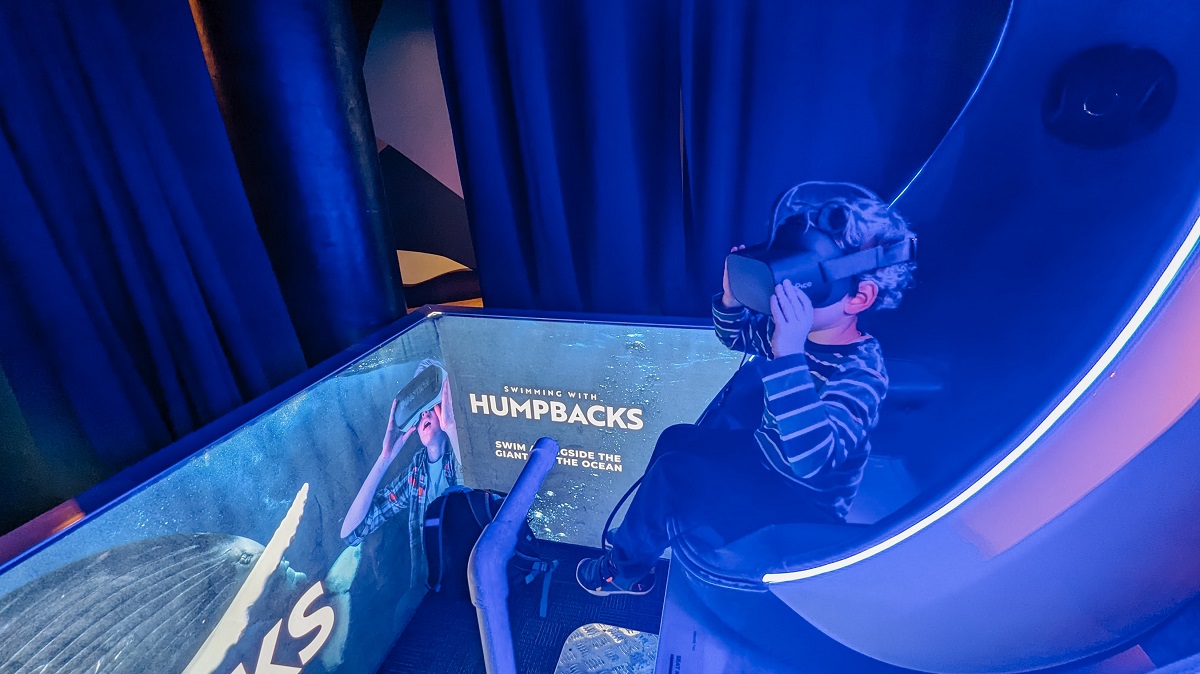
New VR experience
One surprising highlight of our visit was the relatively new Swimming With Humpbacks virtual reality experience. (Find it near the seal habitat; $9 for general admission, $7 for members). Perched in a pod that moves along with the visuals, you really feel like you’re swimming with a mother humpback whale and her calf.
My son felt nervous about putting on the bulky headset at first, but both he and his friend happily hopped out of their pods after the five-minute film ended — and asked to do it again. Note that kids need to be at least 42 inches in height to participate.
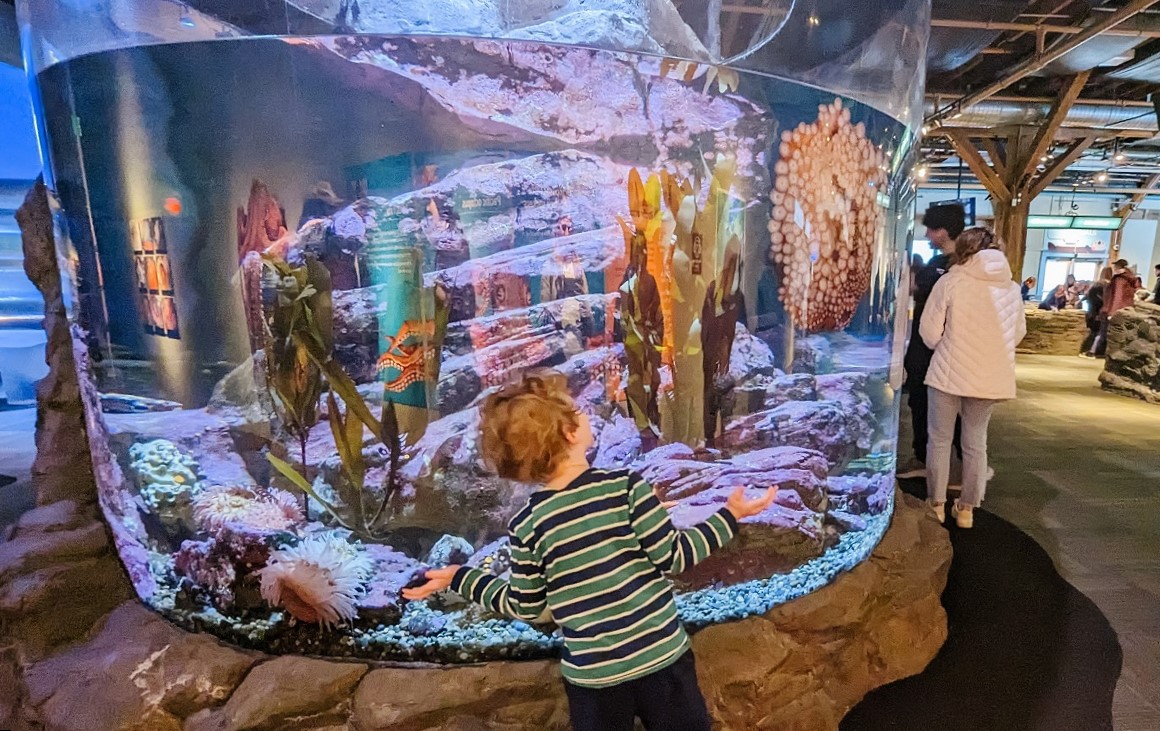
More ways to play and learn
Families who opt for a membership and want deepen their learning experience can check out an activity backpack. Available between October and April, the activity backpacks are stocked with games, puzzles, books and other educational activities for families. Note they are only available to aquarium members.
The welcome staff can provide sensory bags to visitors with sensory challenges who may find the aquarium’s noise and excitement levels to be overwhelming. These are included with the price of admission/membership and are available to any visitor.
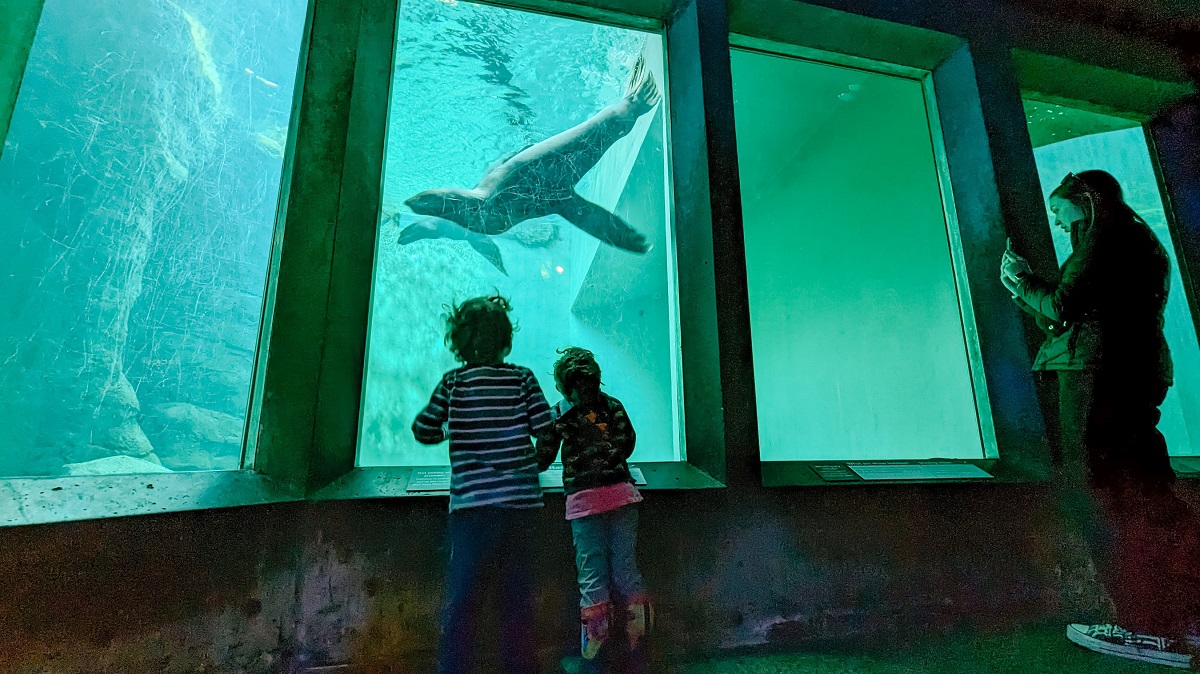
Now, about that parking …
Waterfront construction, which started in 2019 and is expected to continue into 2025, has made navigating and parking on Alaskan Way confusing even for those of use who drive downtown regularly.
What does this mean for you, practically? Be prepared for a bit of a walk, as shown on the aquarium’s helpful map. With your aquarium admission, you’ll get a voucher for two hours of free parking in the Pike Place Market Garage (excess time is paid at the hourly rate).
Remember to allow for the trek back to the car. We watched three moms with double strollers try to squeeze into the slowly moving elevators and opted to walk up the ramp instead. The Hillclimb Garage (which the aquarium used to partner with) is more convenient, but significantly more expensive.
If you choose public transit, you’ll most likely take the light rail or a bus to Westlake Center and need to walk or take a series of elevators a distance of about a half-mile down through Pike Place Market. I usually use this journey as an opportunity to pick up a snack.
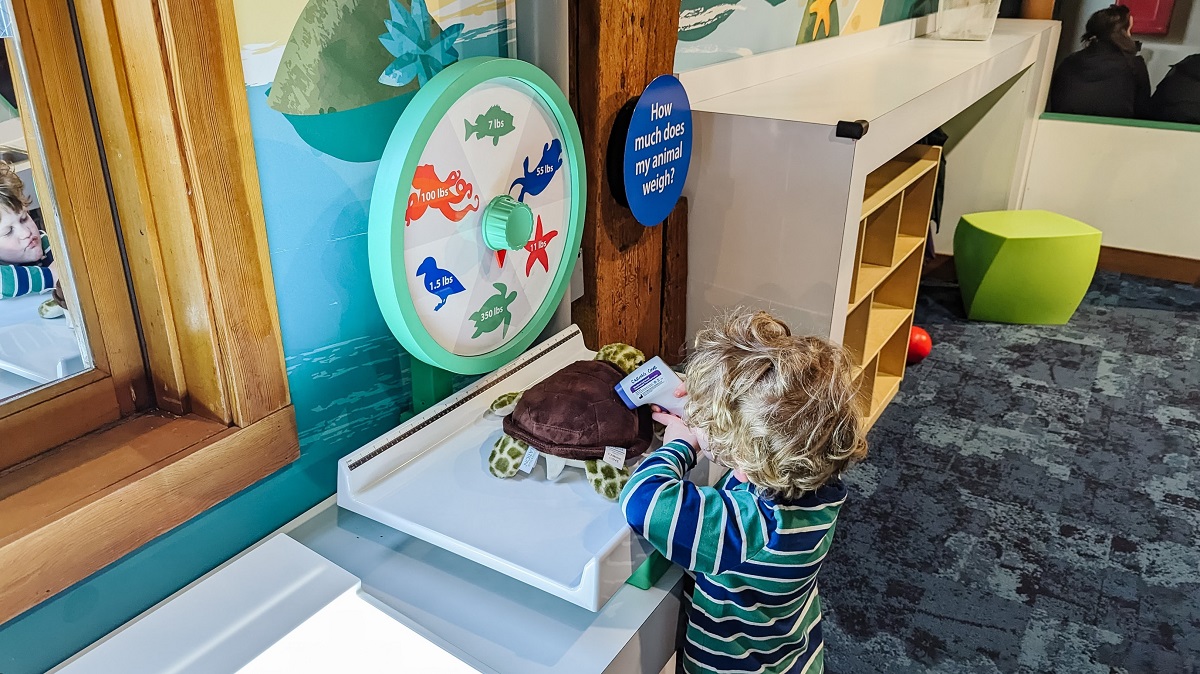
Despite the current challenges accessing the aquarium, it’s still a magical place to explore our local marine ecosystems. Even longtime members will appreciate the refreshed Caring Cove play area that helps engage little visitors longer to make the most of a visit.
Don’t miss these upcoming Seattle Aquarium events and developments:
- DreamNight (Fridays, April 14 and 28): DreamNight offers an opportunity for families with disabilities to explore the aquarium. This free event (please register for only one evening) also includes activities and presentations modified for accessibility needs.
- Toddler Time (select Sundays and Mondays, 9:30 a.m.–noon): The littlest marine biologists (ages 5 and younger) can attend this drop-in program with their adult caregiver. Toddlers might listen to a story, paint a fish, sing with a puppet or dance in a bubble forest. Toddler Time is included admission.
- Beach Naturalist program (select dates throughout summer): This popular program returns June 3. Families just beginning to appreciate tide pool life benefit from naturalist support, while even local experts can enjoy comparing cool creature finds. Free; no registration required.
- Ocean Pavilion: Okay, this isn’t actually scheduled to launch until summer 2024, but the aquarium is expanding! The future addition, supported by a coalition of waterfront organizations, is expected to feature sustainably sourced marine animals, including sharks and rays, and up to 30 species of coral and mangrove trees (which serve as nature’s juvenile fish nursery). Conveniently, completion of the new marine-themed playground at Pier 58 is also expected to occur in 2024, so expect an update from us then!
If you go …Find it: The Seattle Aquarium is located at 1483 Alaskan Way at Pier 59 on Seattle’s waterfront. Hours: The aquarium is open daily, 9:30 a.m.– 6 p.m., with the last entry at 5 p.m. Families that want to add on the Swimming With Humpbacks VR experience can book it at the front desk or right at the kiosk. The 15-minute time slots are subject to change, but are generally available daily, 10–11:45 a.m. and 1–5:15 p.m. Duration: We found plenty to fill our two-hour visit (our time was limited by older sibling school pickups) but we could have stayed longer without that hard stop. Cost: The aquarium uses dynamic pricing (weekends, holidays and last-minute tickets cost more, while purchasing online or showing your Washington driver’s license can save some money). Adult tickets range from $25.95–$36.95, and youth tickets (for ages 4–12) range from $18.20–$25.95. Children ages 3 and younger enter free. Timed tickets are recommended, but no longer required. Families who plan to visit a few times a year may find a family membership to be a worthwhile investment. Parking: Park in the Pike Place Market Garage for up to two hours of free parking. Follow the directions in the aquarium’s helpful map here. Public transit generally serves the Westlake and Pike Place corridor, with a walk down through Pike Place Market adding to the adventure. More fun with preschoolers around Seattle: |











